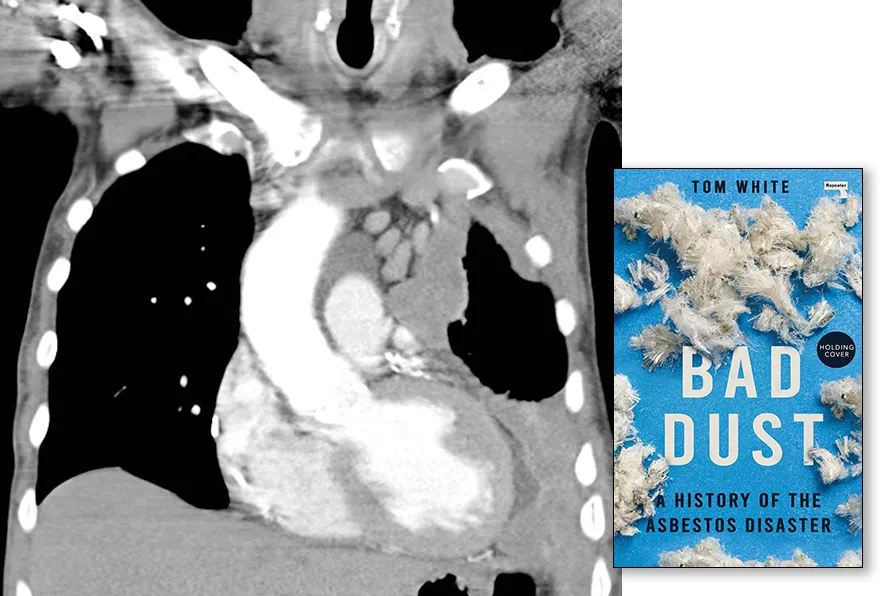MARIA DUARTE picks the best and worst of a crowded year of films
KENNY MACASKILL recommends an informative and highly readable exposure of the asbestos industry

 FATAL EFFECT: The CT scan of the chest in a patient with left sided mesothelioma, showing extensive pleural mass and a contraction of the left hemithorax.[ Pic: Frank Gaillard/CC]
FATAL EFFECT: The CT scan of the chest in a patient with left sided mesothelioma, showing extensive pleural mass and a contraction of the left hemithorax.[ Pic: Frank Gaillard/CC]
Bad Dust: A History of the Asbestos Disaster
Tom White, Repeater, £12.99
THIS book is more than just a narration of the horrific asbestos-related lung diseases which have afflicted and continue to afflict so many. It’s also a cri de coeur.
The author details at the outset that his grandfather died from mesothelioma, a type of cancer linked to asbestos exposure, and was just one of thousands dying every year in this country, prematurely and painfully. This is, as the book narrates, “still the single largest cause of work-related deaths, more than a quarter of a century after it was banned.” Compounding that, official figures like 5,000 deaths in 2021 are believed, with good reason, to be a significant under-reporting.
Despite his personal loss, the author remains focused and analytical, providing an interesting, informative and highly readable account of the product once dubbed the “Magic Mineral.” He details the misery asbestos causes, from its mining by poor and exploited workers, often in developing countries, through its use in industry and construction in this country, to the legacy that endures in Britain with houses, schools and hospitals riddled with it.
Many have suffered and died from asbestos-related illnesses since its discovery in the latter part of the 19th century and its use in industrialising economies and construction. But, as the book points out, unless action is taken it will continue to take its toll for generations as our economy transforms and climate change impacts.
This explains why the author puts the history, use and effects of asbestos in the wider context of capitalism, making the book more than just a retelling of the familiar tale of a product which has proven to be deadly. For this was no tragic accident. The minute fibres which kill and maim are a microcosm of the product, just as the industry is itself a component part of the economic system under which we live.
For me, having had some limited knowledge of asbestos cases when a lawyer, and also from dealing with the issue of pleural plaques when justice secretary, I thought I knew a fair bit about the industry and the disease. Meetings with Clydeside Action on Asbestos and other campaigners showed me that it wasn’t just workers in shipyards but in many other sectors who were affected, and tragically that even their wives, who had simply washed the overalls, were also fatally infected.
But Tom White’s book was still revelatory to me in so many ways, and will be for most reading it. Whilst I was aware that it was a killer, I hadn’t realised that “Britain has the highest rate of mesothelioma per capita in the world.” This is, no doubt, one deadly legacy of the British empire and the industrialisation that took place here.
I have to confess that whilst I knew of Cape and Turner & Newell, the leading manufacturers of asbestos in Britain, I had never linked the former with the Cape Province in South Africa, from where much of product used here would come. The booty of empire would become a “black spot,” like the fatal pirates’ curse, for so many workers in the years that followed.
I was also ashamed to learn that the harm to workers extracting the “naturally occurring silicate minerals” was even greater than that endured here, and that not just miners but their wives and even their children had a role in the process of extraction and paid the ultimate price.
I had also been aware of the difficulties in pursuing companies that have long since gone bust, been sold or that have taken steps to evade responsibility. But the author narrates the shameful attempts to avoid liability as well as delay justice in the knowledge that the very deaths themselves could, at one stage, absolve the companies from paying compensation. The author also shows how the asbestos industry, as with big tobacco and fossil fuels, has lied, distorted and hidden not just evidence, but the truth of the danger throughout the history of the product.
On a happier and more inspiring note the book tells the story of many of the individuals and groups who have fought tenaciously for justice, while also narrating, sadly, the failures of politicians and even trade unions.
This isn’t just the history of a killer product, but an exposure of the asbestos industry as a microcosm of capitalism.










